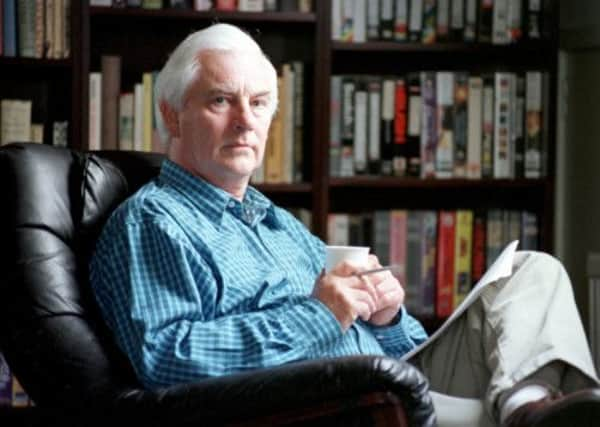Obituary: Frederic Lindsay, novelist


WHEN Frederic Lindsay became a full-time writer in 1978 at the age of 46, all he had ever published were a few poems in a relatively obscure poetry journal. At the time, he was an English lecturer at Hamilton teacher training college, but when it was then threatened with closure he took the opportunity to fulfil an ambition he’d had ever since he was 14. “I realised,” he said later, “that unless I actually got down to writing something substantial, the assumption that I would one day write a novel could be curtailed by a bout of senility.”
The novel he then started working on would leave many people wondering why he had left it so long to change careers. Brond, which was finally published in 1983 by Loanhead publishers MacDonald, was hailed by critics as “a Glaswegian Day of the Jackal” and “like a political thriller written by Kafka” and was judged one of the 100 best Scottish books of all time in a 2005 survey.
Advertisement
Hide AdAdvertisement
Hide AdIn 1987 it was made into a three-part Channel 4 series directed by Michael Caton-Jones, starring Stratford Johns in the lead role as a mysterious killer hunting an IRA terrorist. The series, filmed at a cost of £2.5 million, also gave John Hannah his first lead role on screen, as Robert, a Glasgow student who witnesses Brond throw a child off a bridge in Kelvingrove Park.
Brond marked the arrival of a new talent: a writer who could pose searching questions about the state of Scottish politics and society as well as handle the conventional thriller genre (and later, the police procedural) with panache. It was also, he revealed at the time, a nationalist corrective to Scotch on the Rocks, the thriller co-written by Douglas Hurd. In Hurd’s novel, hardline nationalists were depicted as either fools or thugs; in Brond the villain is unmistakably a British secret agent, in every way less impressive than his near-namesake, Bond.
Frederic Lindsay, known to friends and family as Eric, was born in Glasgow in 1933, the son of a plumber father and teacher mother. On leaving North Kelvinside Secondary School, he worked as a library assistant in the Mitchell Library, before studying at Glasgow University, where he got a first in English. Thereafter, he taught at Annan Academy and lectured at Hamilton College before taking up that long-cherished ambition to be a writer.
Lindsay followed Brond with Jill Rips (1987), a novel about a series of contemporary murders that brought to mind those of Jack the Ripper – except the victims are not prostitutes but their clients, many of whom turn out to be respectable businessmen and local worthies. He was proud of the novel – and dismayed when it was turned into a clunker of a Hollywood film (“an absolutely abominable travesty” he complained) starring Dolph Lundgren in 1999.
Although he wrote three other standalone novels – A Charm Against Drowning (1988), After the Stranger Came (1992) and My Life As A Man (2006) – Lindsay will also be remembered for his series of Edinburgh-based police procedurals starring Detective Inspector Jim Meldrum.
These began in 1997 with Kissing Judas, which Ian Rankin – who knows a fair bit about that particular corner of the crime genre – hailed as an “intelligent, entertaining, gripping and well-written” example of a book that makes it hard to distinguish between the whodunnit and the literary novel.
That point is echoed in Allan Massie’s reviews of the eight Meldrum novels. Writing in The Scotsman about the most recent one – 2008’s The Stranger From Home – he noted they were unusual in that they gained in depth and credibility as the series progressed. In most cases, Massie claimed, the opposite is the case and the quirks the author has given his central character become, in successive books, merely tics. Yet although Meldrum seemed, in early books, to have been drawn from central casting – the good detective whose personal life is a mess – “he has become more interesting because he has become more convincingly troubled, more uncertain of himself, worried, low-spirited, finding it difficult to express the sympathy and affection he feels”.
The depth of Lindsay’s concern with character, Massie argued, even bore comparison with that to be found in Simenon (“and I can’t offer praise higher than that”), yet sales of the Meldrum books always remained disappointingly low. Their author was, Massie added “at once one of the most interesting and under-rated of contemporary Scottish novelists”.
Advertisement
Hide AdAdvertisement
Hide AdLindsay was 21 and working as a librarian when he met his wife Shirley, who was then a student. They married three years later and had four children – three daughters and a son. Although he had always wanted to write, until he gave up teaching, there never seemed to be enough time. Afterwards, however, when the Lindsays moved east (first to near Penicuik and then Pencaitland) there was – as well as the novels, he wrote plays for both the radio and the stage, served on the Scottish Arts Council’s literature panel and was active in Scottish PEN and the Society of Authors. He often paid tribute to Shirley’s work as a primary school teacher for making his own work possible. She survives him, as do their four children and eight grandchildren.
DAVID ROBINSON